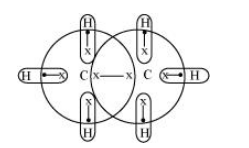Do you expect the carbon hydrides of the type $\left(\mathrm{C}_{n} \mathrm{H}_{2 n+2}\right)$ to act as 'Lewis' acid or base? Justify your answer.
For carbon hydrides of type $\mathrm{C}_{n} \mathrm{H}_{2 n+2}$, the following hydrides are possible for
$n=1 \Rightarrow \mathrm{CH}_{4}$
$n=2 \Rightarrow \mathrm{C}_{2} \mathrm{H}_{6}$
$n=3 \Rightarrow \mathrm{C}_{3} \mathrm{H}_{8}$
For a hydride to act as a Lewis acid i.e., electron accepting, it should be electron-deficient. Also, for it to act as a Lewis base i.e., electron donating, it should be electron-rich.
Taking $\mathrm{C}_{2} \mathrm{H}_{6}$ as an example, the total number of electrons are 14 and the total covalent bonds are seven. Hence, the bonds are regular $2 \mathrm{e}^{-}-2$ centered bonds.

Hence, hydride $\mathrm{C}_{2} \mathrm{H}_{6}$ has sufficient electrons to be represented by a conventional Lewis structure. Therefore, it is an electron-precise hydride, having all atoms with complete octets. Thus, it can neither donate nor accept electrons to act as a Lewis acid or Lewis base.
Click here to get exam-ready with eSaral
For making your preparation journey smoother of JEE, NEET and Class 8 to 10, grab our app now.
